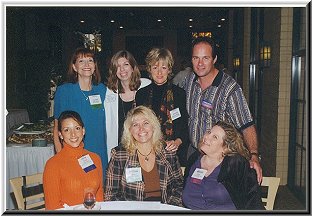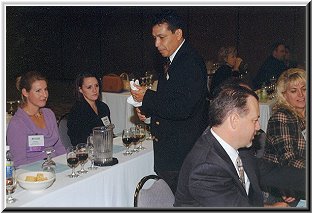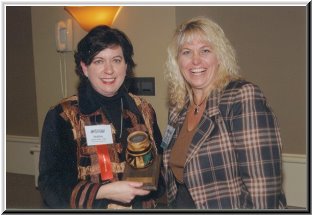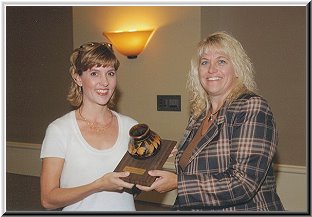
OCTOBER MEETING RECAP
From notes By Debbie J. Elder, CMP

"Entertaining With Wine"
Debbie J. Elder, CMP
Designer of Wine Events, The Grape Connection
Our appreciation of wine has changed dramatically in the past 40 years and today we are expected to be experts on "Entertaining with Wine." According to Mary Ewing-Mulligan, Co-Author of Wine for Dummies, "wine knowledge is a powerful tool for today's businessperson." She goes on to say that "this knowledge provides leverage in all business entertaining."
In many cases, you may be entertaining within your hotel's restaurant facilities so it is fairly easy to become knowledgeable about the wine list. What happens if you are going out to a restaurant and you are not familiar with the wine list? Is it reasonable to request a copy of the wine list in advance? Sure. This will give you time to research the wines offered. Your research can be conducted via the internet, or by talking with the staff at a local wine shop. Or, if it is a very important event, ask the restaurant to offer you a tasting.
A wine list is typically arranged by the grape varietal, or the style of wine. It will start with the sparkling wines or Champagne (can only be called "Champagne" if it is grown in a particular region in France). White wines will follow, then reds. Lighter bodied wines are listed before medium or full-bodied wines. This is the same order you would use if you are sampling more than one wine at a meal. Start with the lightest before heaviest. White before red. Young before old. One other hint is to serve the most expensive first, followed by the least. Now, let's move on to the tasting process. Here are a few quick tips on the best way to taste the wine:
- Hold the glass by the stem or the foot.
- Never put your hands around the bowl - fingerprints; warming effect.
- Look at the color. It should be clear, not cloudy. Hold up the wine to a white paper or white napkin.
- Swirl the wine - aerate the wine - releases the bouquet.
- Sniff - inhale deeply into the glass.
- Sip - swish or gurgle the wine in your mouth to hit all of your taste buds.
- Savor- think about the wine in terms of aromas and flavors.
Now, let's talk about the wine Sommelier. This person
is an expert in wine. They will have taken courses, tasted thousands of
wines, and passed examinations proving their knowledge. This person is
a resource to you and should be utilized.

What happens when the Sommelier brings you the wine? The wine will be opened at your table. A very small amount will be poured into your glass, the cork presented to you, and the bottle label shown to you. Your role as host is to make sure the bottle is what you ordered. Look at the label. Check the winery name, varietal and vintage (year the wine was bottled.) Look at the cork. DO NOT SMELL the cork. Look for leakage or softness in the cork which may indicate that the wine was exposed to air, resulting in the wine tasting "off" or "tainted."
Taste the wine as previously reviewed. If it tastes "corked" or vinegary, do not hesitate to send it back. It is surprising fact that nearly 5% of all wines are "corked" or "corky." This is caused by the bleaching process used to disinfect corks causing the formation of a chemical called "trich-lo-ro-phen-ol or (TCA)"
What if there isn't a Sommelier and you want to select a wine that will go best with your meal? All food flavors can be described in combinations of four basic components: tartness, sweetness, saltiness and bitterness. Since wine is a food, it follows the same pattern of flavors.
Tartness: Acidity is the single most important issue in matching wine with food. Acidity in wine penetrates the richness of ingredients or sauces (such as butter or cream) to refresh the palate. It mirrors tart items, such as vinaigrette, lemon, tomatoes and capers. It decreases the oiliness in foods, like pizza, or anything pan-sauteed, or deep-fried. It lightens the flavor of oily fish or shellfish. Essentially, it brings out the flavors in food.
Sweetness: Residual sugar, which is left in the wine after fermentation has been stopped, is present in all wines. Even wines that are considered to be "bone dry" may well contain a certain amount of sugar in their chemistry. Moderately hot foods (cayenne, red peppers) can be foiled with sweet wine, which actually takes the edge off the heat. Sweet wines can also mirror a slight sweetness in condiments such as chutney or sauces with fresh or dried fruit. Also, remember dessert wines should always be sweeter than the food served for dessert.
Saltiness: Salt can both cut and accentuate sweetness. While wine itself is not salty, its effect on salty food can be dramatic. Be aware that acidity in wine cuts saltiness. Therefore, sparkling wines and other whites with higher levels of acidity generally work with salty foods better than less tart wines (like most red wines)
Bitterness: Bitterness can add balance, character and appealing flavor components. The most common source of bitterness in a wine is the level of tannins, which are naturally bitter. The higher the tannin level, the more bitter the wine. Wines with tannins and bitterness are best matched with like-flavored foods (grilled, charred and blackened foods.) The bitter flavors of sautéed broccoli rabe, arugula, eggplant and bell peppers are good candidates for pairing with bitter wines.
Other Elements: Alcohol gives wine a sense of body and weight. Generally, the higher the alcohol, the more full-bodied the wine. When it comes to body, a good rule of thumb is to match wines and foods of equal weight.
The amount of time the wine is spent in the oak barrel will affect the taste. Oak, like grapes, contains tannins, which are naturally both bitter and astringent. Food will exaggerate the oak flavor in wine. There are several foods that just don't work with wine: vinegar, green peppers, artichokes, asparagus and in most cases, anchovies.
I wanted to share with you a little information about wine serving temperatures and storage. White wines should be chilled to between 40 and 50 degrees for best enjoyment. Most of us have been taught that red wine should be served at room temperature. But that doesn't take soaring Arizona temperatures into account. Red wines should be served between 58 and 65 degrees. Wine can be chilled down in a bucket of ice water in about 20 minutes. Don't store wine in the kitchen - hottest room in the house. Store the wine on its side - not upright. Transporting wine from the grocery store or wine shop to your house can also pose problems. Using a cooler is the best answer.
I also wanted to briefly mention glassware. There are specific glasses for each type of wine varietal that allows the wine to best release the bouquet, or to hold the aroma. A good choice is the "tulip" shape, where the bowl of the glass curves inwards at the top. Fill the glass not more than one- third to one-half full. The most important point to remember with a wine glass is for it to have a stem, permitting the wine to be swirled, sloshed and sipped without warming it up with your hand.
This should give you a good comfort level while entertaining. To further build your confidence on this subject, I encourage you to attend wine tastings, many of which are held weekly at the local wine shops. Read about the subject through wine and food magazines, books, or on the Internet. There are also many wine authorities within your properties beyond the Sommelier, who are happy to share their knowledge.


HSMAI extends a special thank you to Debbie Elder, CMP,
our October speaker, the Orangetree Golf Resort and Richard Carmer, Photos
Plus for helping to make this a very informational and fun event!